Independent Study for Accountants: Decision Making and Accounting
VerifiedAdded on 2020/03/16
|29
|6809
|167
Thesis and Dissertation
AI Summary
This thesis, an independent study for accountants, investigates the role and impact of accounting in decision-making. The study, conducted by Lim Teck Wai, examines the influence of Accounting Information Systems (AIS) on the quality of decisions made by management. The research includes a literature review, research design, methodology, data analysis, and hypothesis testing. It explores the relationship between AIS and worker perception, identifies factors affecting accounting information, and assesses the impact of AIS on secondary school performance. The study uses both primary and secondary data, employing statistical instruments to analyze the collected information. The findings are presented with interpretations, discussions, and recommendations, concluding with insights into how AIS can enhance decision-making processes within organizations.
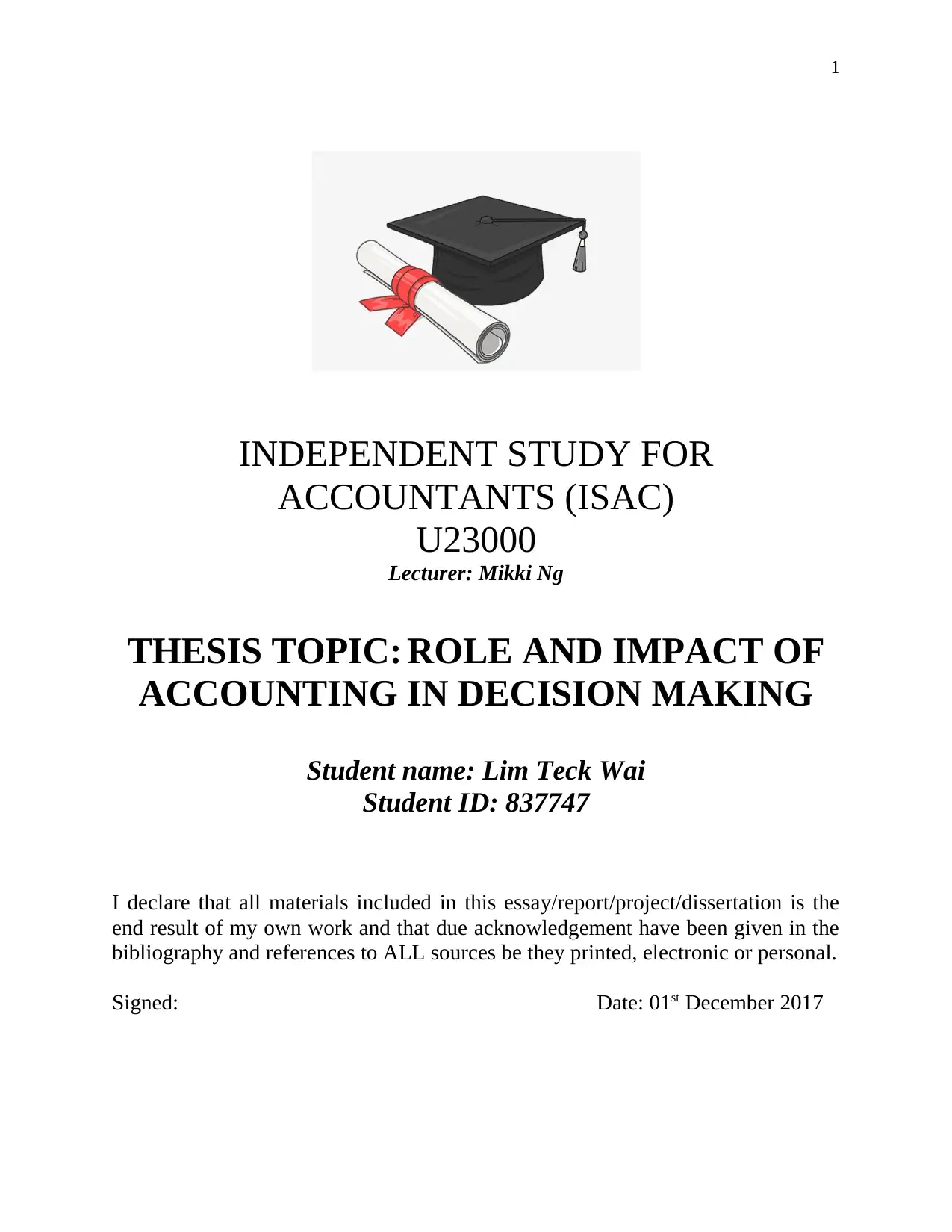
1
INDEPENDENT STUDY FOR
ACCOUNTANTS (ISAC)
U23000
Lecturer: Mikki Ng
THESIS TOPIC: ROLE AND IMPACT OF
ACCOUNTING IN DECISION MAKING
Student name: Lim Teck Wai
Student ID: 837747
I declare that all materials included in this essay/report/project/dissertation is the
end result of my own work and that due acknowledgement have been given in the
bibliography and references to ALL sources be they printed, electronic or personal.
Signed: Date: 01st December 2017
INDEPENDENT STUDY FOR
ACCOUNTANTS (ISAC)
U23000
Lecturer: Mikki Ng
THESIS TOPIC: ROLE AND IMPACT OF
ACCOUNTING IN DECISION MAKING
Student name: Lim Teck Wai
Student ID: 837747
I declare that all materials included in this essay/report/project/dissertation is the
end result of my own work and that due acknowledgement have been given in the
bibliography and references to ALL sources be they printed, electronic or personal.
Signed: Date: 01st December 2017
Paraphrase This Document
Need a fresh take? Get an instant paraphrase of this document with our AI Paraphraser
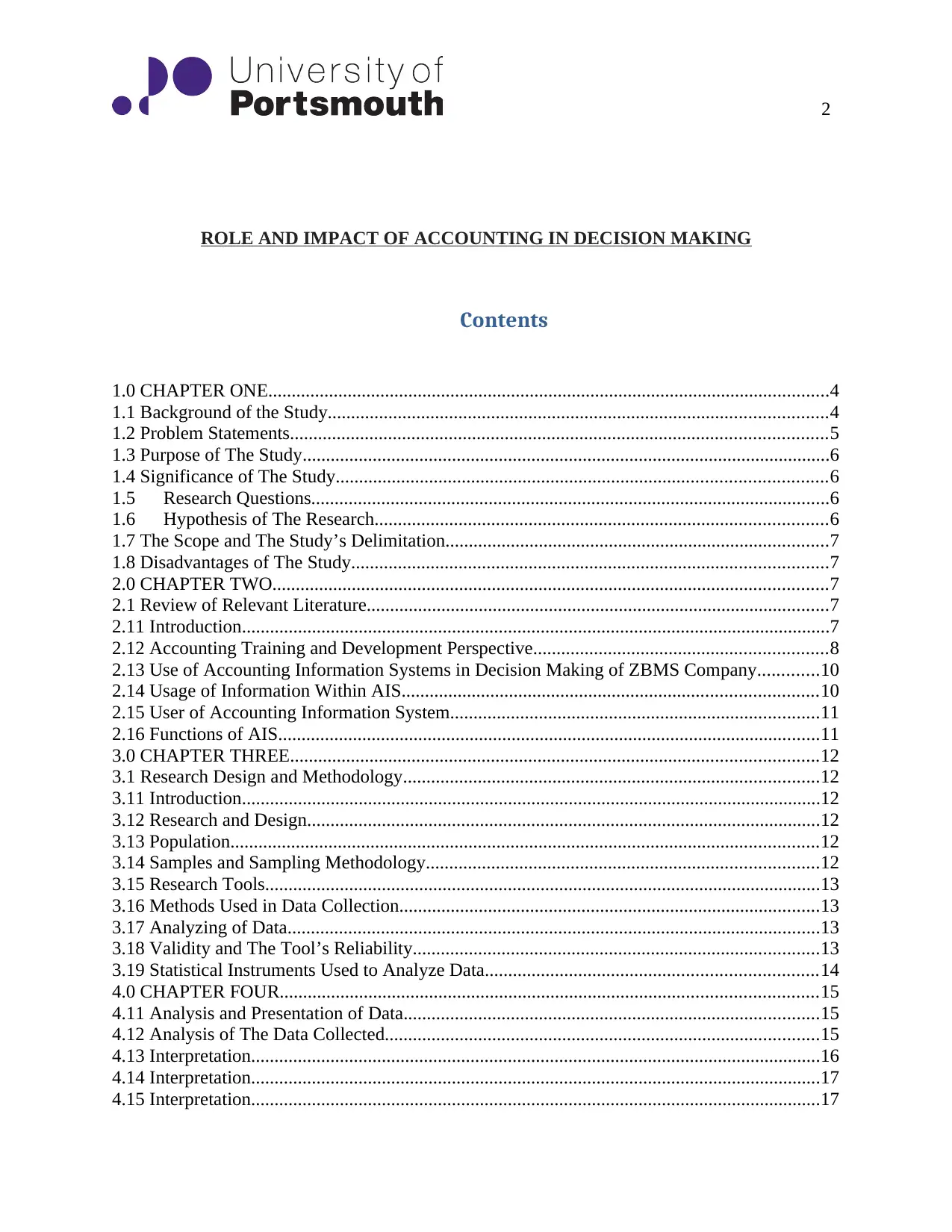
2
ROLE AND IMPACT OF ACCOUNTING IN DECISION MAKING
Contents
1.0 CHAPTER ONE........................................................................................................................4
1.1 Background of the Study...........................................................................................................4
1.2 Problem Statements...................................................................................................................5
1.3 Purpose of The Study.................................................................................................................6
1.4 Significance of The Study.........................................................................................................6
1.5 Research Questions...............................................................................................................6
1.6 Hypothesis of The Research.................................................................................................6
1.7 The Scope and The Study’s Delimitation..................................................................................7
1.8 Disadvantages of The Study......................................................................................................7
2.0 CHAPTER TWO.......................................................................................................................7
2.1 Review of Relevant Literature...................................................................................................7
2.11 Introduction..............................................................................................................................7
2.12 Accounting Training and Development Perspective...............................................................8
2.13 Use of Accounting Information Systems in Decision Making of ZBMS Company.............10
2.14 Usage of Information Within AIS.........................................................................................10
2.15 User of Accounting Information System...............................................................................11
2.16 Functions of AIS....................................................................................................................11
3.0 CHAPTER THREE.................................................................................................................12
3.1 Research Design and Methodology.........................................................................................12
3.11 Introduction............................................................................................................................12
3.12 Research and Design..............................................................................................................12
3.13 Population..............................................................................................................................12
3.14 Samples and Sampling Methodology....................................................................................12
3.15 Research Tools.......................................................................................................................13
3.16 Methods Used in Data Collection..........................................................................................13
3.17 Analyzing of Data..................................................................................................................13
3.18 Validity and The Tool’s Reliability.......................................................................................13
3.19 Statistical Instruments Used to Analyze Data.......................................................................14
4.0 CHAPTER FOUR...................................................................................................................15
4.11 Analysis and Presentation of Data.........................................................................................15
4.12 Analysis of The Data Collected.............................................................................................15
4.13 Interpretation..........................................................................................................................16
4.14 Interpretation..........................................................................................................................17
4.15 Interpretation..........................................................................................................................17
ROLE AND IMPACT OF ACCOUNTING IN DECISION MAKING
Contents
1.0 CHAPTER ONE........................................................................................................................4
1.1 Background of the Study...........................................................................................................4
1.2 Problem Statements...................................................................................................................5
1.3 Purpose of The Study.................................................................................................................6
1.4 Significance of The Study.........................................................................................................6
1.5 Research Questions...............................................................................................................6
1.6 Hypothesis of The Research.................................................................................................6
1.7 The Scope and The Study’s Delimitation..................................................................................7
1.8 Disadvantages of The Study......................................................................................................7
2.0 CHAPTER TWO.......................................................................................................................7
2.1 Review of Relevant Literature...................................................................................................7
2.11 Introduction..............................................................................................................................7
2.12 Accounting Training and Development Perspective...............................................................8
2.13 Use of Accounting Information Systems in Decision Making of ZBMS Company.............10
2.14 Usage of Information Within AIS.........................................................................................10
2.15 User of Accounting Information System...............................................................................11
2.16 Functions of AIS....................................................................................................................11
3.0 CHAPTER THREE.................................................................................................................12
3.1 Research Design and Methodology.........................................................................................12
3.11 Introduction............................................................................................................................12
3.12 Research and Design..............................................................................................................12
3.13 Population..............................................................................................................................12
3.14 Samples and Sampling Methodology....................................................................................12
3.15 Research Tools.......................................................................................................................13
3.16 Methods Used in Data Collection..........................................................................................13
3.17 Analyzing of Data..................................................................................................................13
3.18 Validity and The Tool’s Reliability.......................................................................................13
3.19 Statistical Instruments Used to Analyze Data.......................................................................14
4.0 CHAPTER FOUR...................................................................................................................15
4.11 Analysis and Presentation of Data.........................................................................................15
4.12 Analysis of The Data Collected.............................................................................................15
4.13 Interpretation..........................................................................................................................16
4.14 Interpretation..........................................................................................................................17
4.15 Interpretation..........................................................................................................................17
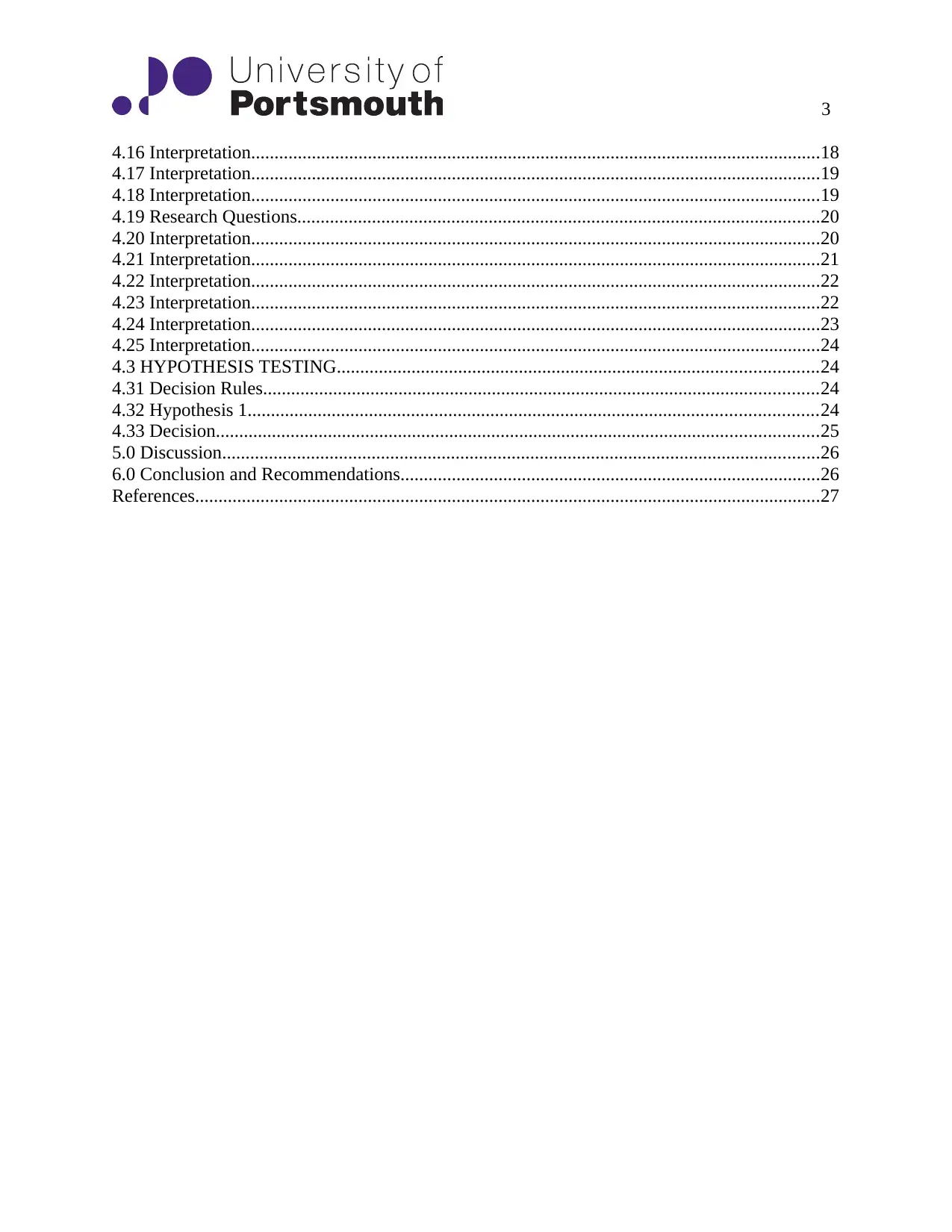
3
4.16 Interpretation..........................................................................................................................18
4.17 Interpretation..........................................................................................................................19
4.18 Interpretation..........................................................................................................................19
4.19 Research Questions................................................................................................................20
4.20 Interpretation..........................................................................................................................20
4.21 Interpretation..........................................................................................................................21
4.22 Interpretation..........................................................................................................................22
4.23 Interpretation..........................................................................................................................22
4.24 Interpretation..........................................................................................................................23
4.25 Interpretation..........................................................................................................................24
4.3 HYPOTHESIS TESTING.......................................................................................................24
4.31 Decision Rules.......................................................................................................................24
4.32 Hypothesis 1..........................................................................................................................24
4.33 Decision.................................................................................................................................25
5.0 Discussion................................................................................................................................26
6.0 Conclusion and Recommendations..........................................................................................26
References......................................................................................................................................27
4.16 Interpretation..........................................................................................................................18
4.17 Interpretation..........................................................................................................................19
4.18 Interpretation..........................................................................................................................19
4.19 Research Questions................................................................................................................20
4.20 Interpretation..........................................................................................................................20
4.21 Interpretation..........................................................................................................................21
4.22 Interpretation..........................................................................................................................22
4.23 Interpretation..........................................................................................................................22
4.24 Interpretation..........................................................................................................................23
4.25 Interpretation..........................................................................................................................24
4.3 HYPOTHESIS TESTING.......................................................................................................24
4.31 Decision Rules.......................................................................................................................24
4.32 Hypothesis 1..........................................................................................................................24
4.33 Decision.................................................................................................................................25
5.0 Discussion................................................................................................................................26
6.0 Conclusion and Recommendations..........................................................................................26
References......................................................................................................................................27
⊘ This is a preview!⊘
Do you want full access?
Subscribe today to unlock all pages.

Trusted by 1+ million students worldwide
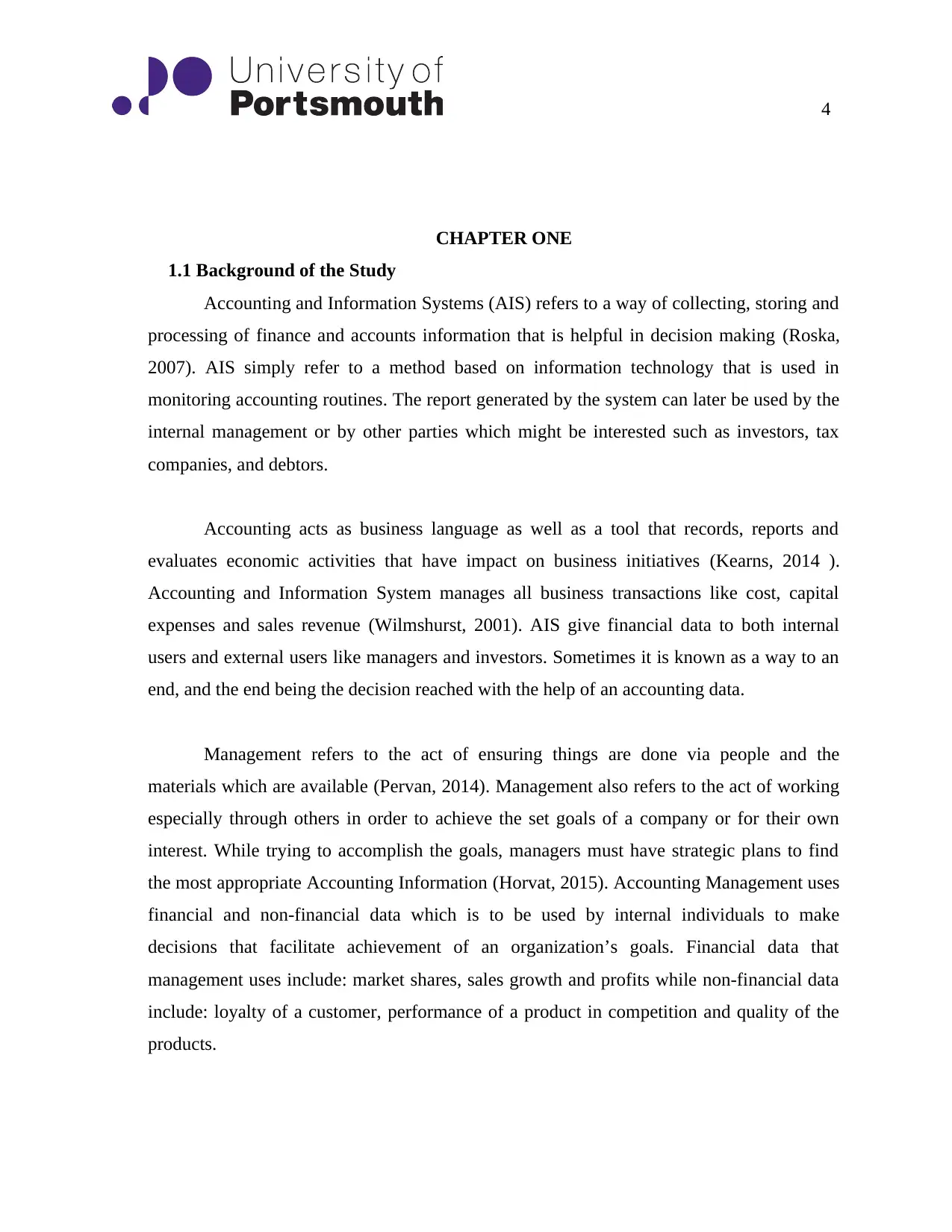
4
CHAPTER ONE
1.1 Background of the Study
Accounting and Information Systems (AIS) refers to a way of collecting, storing and
processing of finance and accounts information that is helpful in decision making (Roska,
2007). AIS simply refer to a method based on information technology that is used in
monitoring accounting routines. The report generated by the system can later be used by the
internal management or by other parties which might be interested such as investors, tax
companies, and debtors.
Accounting acts as business language as well as a tool that records, reports and
evaluates economic activities that have impact on business initiatives (Kearns, 2014 ).
Accounting and Information System manages all business transactions like cost, capital
expenses and sales revenue (Wilmshurst, 2001). AIS give financial data to both internal
users and external users like managers and investors. Sometimes it is known as a way to an
end, and the end being the decision reached with the help of an accounting data.
Management refers to the act of ensuring things are done via people and the
materials which are available (Pervan, 2014). Management also refers to the act of working
especially through others in order to achieve the set goals of a company or for their own
interest. While trying to accomplish the goals, managers must have strategic plans to find
the most appropriate Accounting Information (Horvat, 2015). Accounting Management uses
financial and non-financial data which is to be used by internal individuals to make
decisions that facilitate achievement of an organization’s goals. Financial data that
management uses include: market shares, sales growth and profits while non-financial data
include: loyalty of a customer, performance of a product in competition and quality of the
products.
CHAPTER ONE
1.1 Background of the Study
Accounting and Information Systems (AIS) refers to a way of collecting, storing and
processing of finance and accounts information that is helpful in decision making (Roska,
2007). AIS simply refer to a method based on information technology that is used in
monitoring accounting routines. The report generated by the system can later be used by the
internal management or by other parties which might be interested such as investors, tax
companies, and debtors.
Accounting acts as business language as well as a tool that records, reports and
evaluates economic activities that have impact on business initiatives (Kearns, 2014 ).
Accounting and Information System manages all business transactions like cost, capital
expenses and sales revenue (Wilmshurst, 2001). AIS give financial data to both internal
users and external users like managers and investors. Sometimes it is known as a way to an
end, and the end being the decision reached with the help of an accounting data.
Management refers to the act of ensuring things are done via people and the
materials which are available (Pervan, 2014). Management also refers to the act of working
especially through others in order to achieve the set goals of a company or for their own
interest. While trying to accomplish the goals, managers must have strategic plans to find
the most appropriate Accounting Information (Horvat, 2015). Accounting Management uses
financial and non-financial data which is to be used by internal individuals to make
decisions that facilitate achievement of an organization’s goals. Financial data that
management uses include: market shares, sales growth and profits while non-financial data
include: loyalty of a customer, performance of a product in competition and quality of the
products.
Paraphrase This Document
Need a fresh take? Get an instant paraphrase of this document with our AI Paraphraser
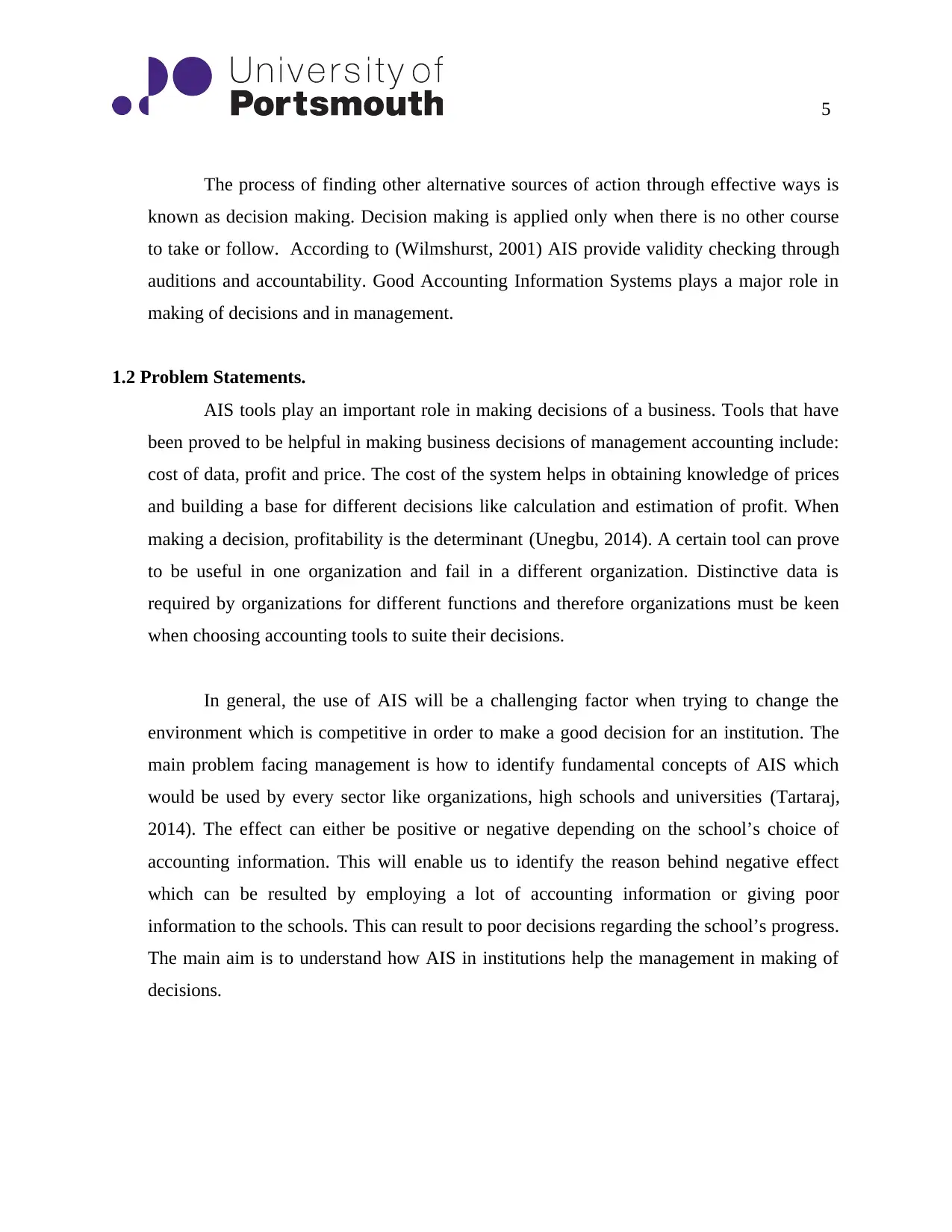
5
The process of finding other alternative sources of action through effective ways is
known as decision making. Decision making is applied only when there is no other course
to take or follow. According to (Wilmshurst, 2001) AIS provide validity checking through
auditions and accountability. Good Accounting Information Systems plays a major role in
making of decisions and in management.
1.2 Problem Statements.
AIS tools play an important role in making decisions of a business. Tools that have
been proved to be helpful in making business decisions of management accounting include:
cost of data, profit and price. The cost of the system helps in obtaining knowledge of prices
and building a base for different decisions like calculation and estimation of profit. When
making a decision, profitability is the determinant (Unegbu, 2014). A certain tool can prove
to be useful in one organization and fail in a different organization. Distinctive data is
required by organizations for different functions and therefore organizations must be keen
when choosing accounting tools to suite their decisions.
In general, the use of AIS will be a challenging factor when trying to change the
environment which is competitive in order to make a good decision for an institution. The
main problem facing management is how to identify fundamental concepts of AIS which
would be used by every sector like organizations, high schools and universities (Tartaraj,
2014). The effect can either be positive or negative depending on the school’s choice of
accounting information. This will enable us to identify the reason behind negative effect
which can be resulted by employing a lot of accounting information or giving poor
information to the schools. This can result to poor decisions regarding the school’s progress.
The main aim is to understand how AIS in institutions help the management in making of
decisions.
The process of finding other alternative sources of action through effective ways is
known as decision making. Decision making is applied only when there is no other course
to take or follow. According to (Wilmshurst, 2001) AIS provide validity checking through
auditions and accountability. Good Accounting Information Systems plays a major role in
making of decisions and in management.
1.2 Problem Statements.
AIS tools play an important role in making decisions of a business. Tools that have
been proved to be helpful in making business decisions of management accounting include:
cost of data, profit and price. The cost of the system helps in obtaining knowledge of prices
and building a base for different decisions like calculation and estimation of profit. When
making a decision, profitability is the determinant (Unegbu, 2014). A certain tool can prove
to be useful in one organization and fail in a different organization. Distinctive data is
required by organizations for different functions and therefore organizations must be keen
when choosing accounting tools to suite their decisions.
In general, the use of AIS will be a challenging factor when trying to change the
environment which is competitive in order to make a good decision for an institution. The
main problem facing management is how to identify fundamental concepts of AIS which
would be used by every sector like organizations, high schools and universities (Tartaraj,
2014). The effect can either be positive or negative depending on the school’s choice of
accounting information. This will enable us to identify the reason behind negative effect
which can be resulted by employing a lot of accounting information or giving poor
information to the schools. This can result to poor decisions regarding the school’s progress.
The main aim is to understand how AIS in institutions help the management in making of
decisions.
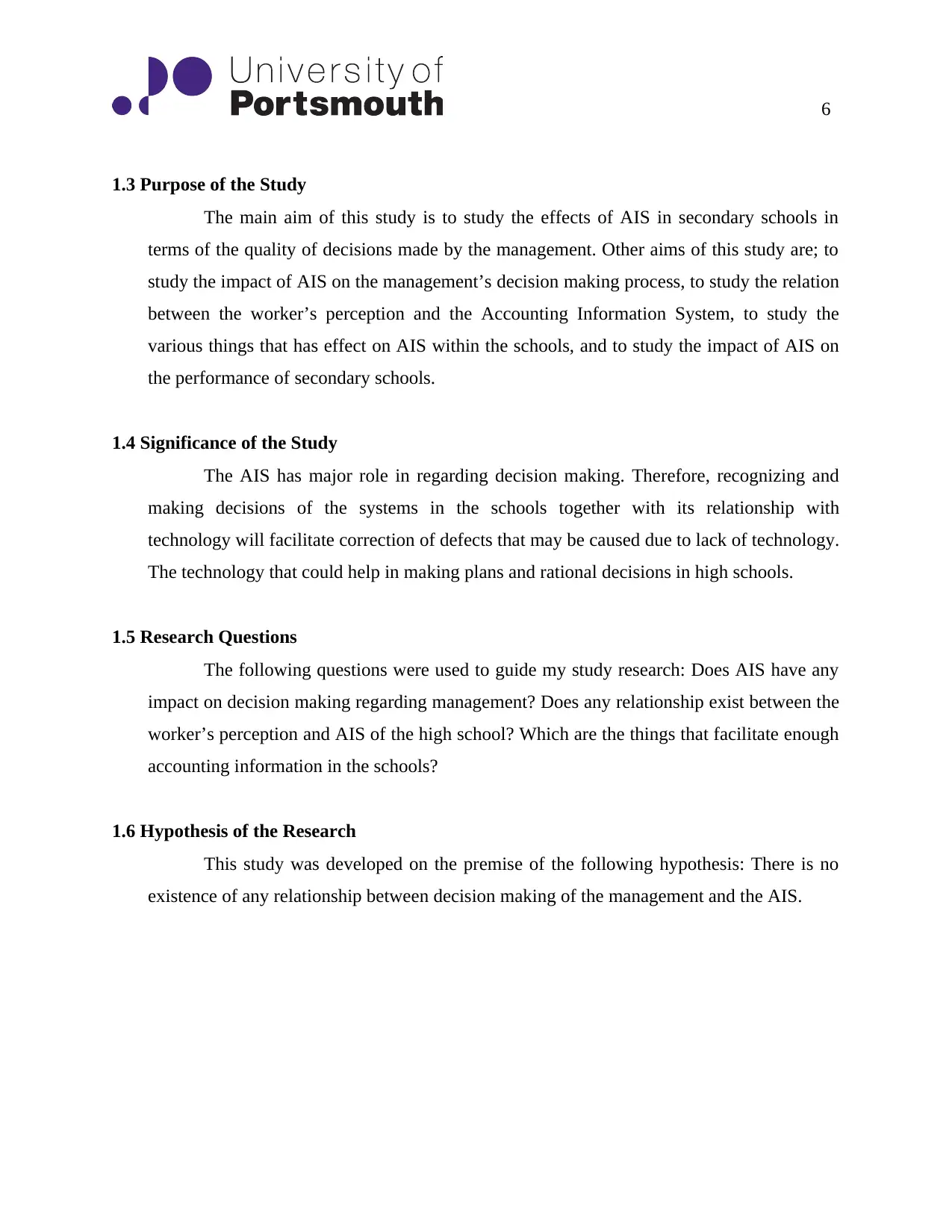
6
1.3 Purpose of the Study
The main aim of this study is to study the effects of AIS in secondary schools in
terms of the quality of decisions made by the management. Other aims of this study are; to
study the impact of AIS on the management’s decision making process, to study the relation
between the worker’s perception and the Accounting Information System, to study the
various things that has effect on AIS within the schools, and to study the impact of AIS on
the performance of secondary schools.
1.4 Significance of the Study
The AIS has major role in regarding decision making. Therefore, recognizing and
making decisions of the systems in the schools together with its relationship with
technology will facilitate correction of defects that may be caused due to lack of technology.
The technology that could help in making plans and rational decisions in high schools.
1.5 Research Questions
The following questions were used to guide my study research: Does AIS have any
impact on decision making regarding management? Does any relationship exist between the
worker’s perception and AIS of the high school? Which are the things that facilitate enough
accounting information in the schools?
1.6 Hypothesis of the Research
This study was developed on the premise of the following hypothesis: There is no
existence of any relationship between decision making of the management and the AIS.
1.3 Purpose of the Study
The main aim of this study is to study the effects of AIS in secondary schools in
terms of the quality of decisions made by the management. Other aims of this study are; to
study the impact of AIS on the management’s decision making process, to study the relation
between the worker’s perception and the Accounting Information System, to study the
various things that has effect on AIS within the schools, and to study the impact of AIS on
the performance of secondary schools.
1.4 Significance of the Study
The AIS has major role in regarding decision making. Therefore, recognizing and
making decisions of the systems in the schools together with its relationship with
technology will facilitate correction of defects that may be caused due to lack of technology.
The technology that could help in making plans and rational decisions in high schools.
1.5 Research Questions
The following questions were used to guide my study research: Does AIS have any
impact on decision making regarding management? Does any relationship exist between the
worker’s perception and AIS of the high school? Which are the things that facilitate enough
accounting information in the schools?
1.6 Hypothesis of the Research
This study was developed on the premise of the following hypothesis: There is no
existence of any relationship between decision making of the management and the AIS.
⊘ This is a preview!⊘
Do you want full access?
Subscribe today to unlock all pages.

Trusted by 1+ million students worldwide
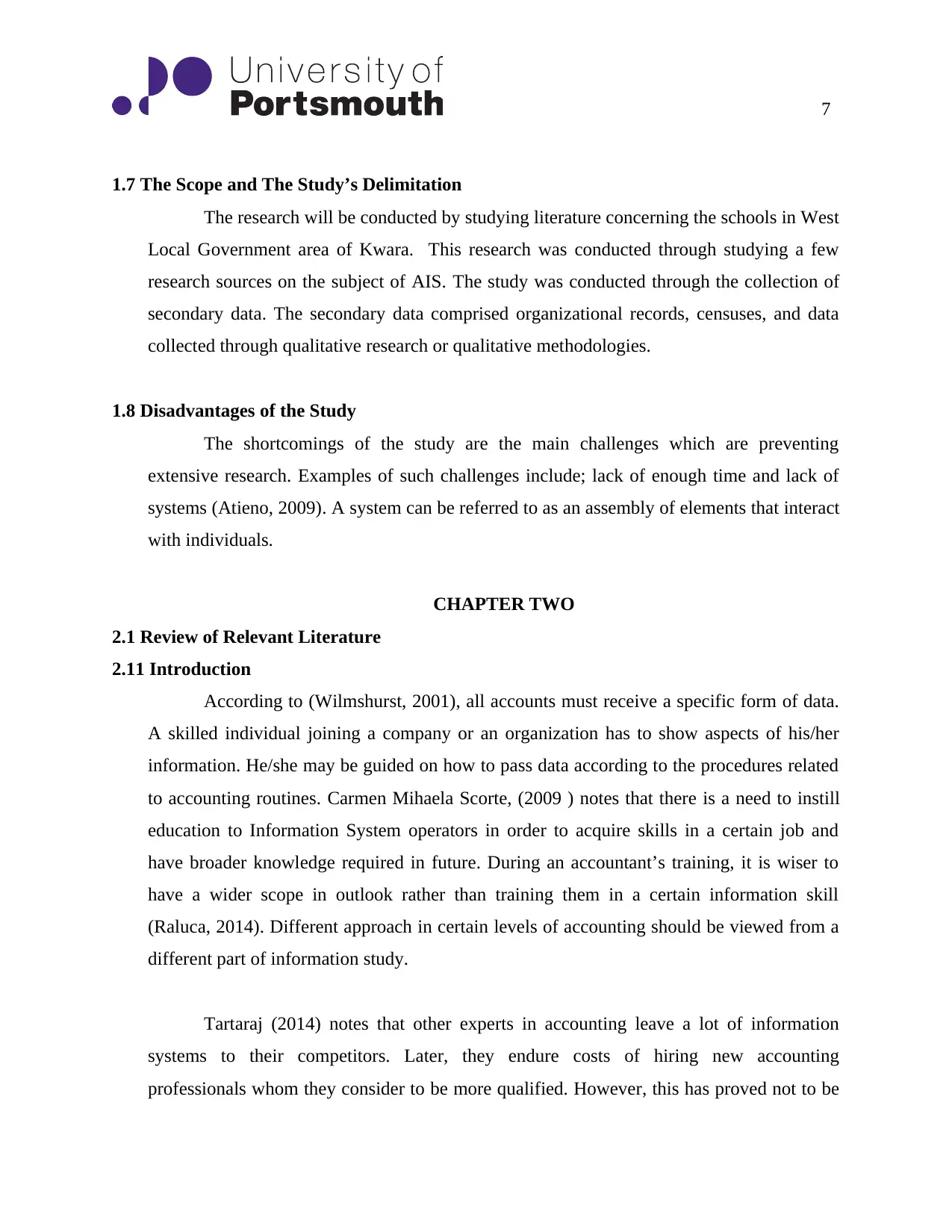
7
1.7 The Scope and The Study’s Delimitation
The research will be conducted by studying literature concerning the schools in West
Local Government area of Kwara. This research was conducted through studying a few
research sources on the subject of AIS. The study was conducted through the collection of
secondary data. The secondary data comprised organizational records, censuses, and data
collected through qualitative research or qualitative methodologies.
1.8 Disadvantages of the Study
The shortcomings of the study are the main challenges which are preventing
extensive research. Examples of such challenges include; lack of enough time and lack of
systems (Atieno, 2009). A system can be referred to as an assembly of elements that interact
with individuals.
CHAPTER TWO
2.1 Review of Relevant Literature
2.11 Introduction
According to (Wilmshurst, 2001), all accounts must receive a specific form of data.
A skilled individual joining a company or an organization has to show aspects of his/her
information. He/she may be guided on how to pass data according to the procedures related
to accounting routines. Carmen Mihaela Scorte, (2009 ) notes that there is a need to instill
education to Information System operators in order to acquire skills in a certain job and
have broader knowledge required in future. During an accountant’s training, it is wiser to
have a wider scope in outlook rather than training them in a certain information skill
(Raluca, 2014). Different approach in certain levels of accounting should be viewed from a
different part of information study.
Tartaraj (2014) notes that other experts in accounting leave a lot of information
systems to their competitors. Later, they endure costs of hiring new accounting
professionals whom they consider to be more qualified. However, this has proved not to be
1.7 The Scope and The Study’s Delimitation
The research will be conducted by studying literature concerning the schools in West
Local Government area of Kwara. This research was conducted through studying a few
research sources on the subject of AIS. The study was conducted through the collection of
secondary data. The secondary data comprised organizational records, censuses, and data
collected through qualitative research or qualitative methodologies.
1.8 Disadvantages of the Study
The shortcomings of the study are the main challenges which are preventing
extensive research. Examples of such challenges include; lack of enough time and lack of
systems (Atieno, 2009). A system can be referred to as an assembly of elements that interact
with individuals.
CHAPTER TWO
2.1 Review of Relevant Literature
2.11 Introduction
According to (Wilmshurst, 2001), all accounts must receive a specific form of data.
A skilled individual joining a company or an organization has to show aspects of his/her
information. He/she may be guided on how to pass data according to the procedures related
to accounting routines. Carmen Mihaela Scorte, (2009 ) notes that there is a need to instill
education to Information System operators in order to acquire skills in a certain job and
have broader knowledge required in future. During an accountant’s training, it is wiser to
have a wider scope in outlook rather than training them in a certain information skill
(Raluca, 2014). Different approach in certain levels of accounting should be viewed from a
different part of information study.
Tartaraj (2014) notes that other experts in accounting leave a lot of information
systems to their competitors. Later, they endure costs of hiring new accounting
professionals whom they consider to be more qualified. However, this has proved not to be
Paraphrase This Document
Need a fresh take? Get an instant paraphrase of this document with our AI Paraphraser
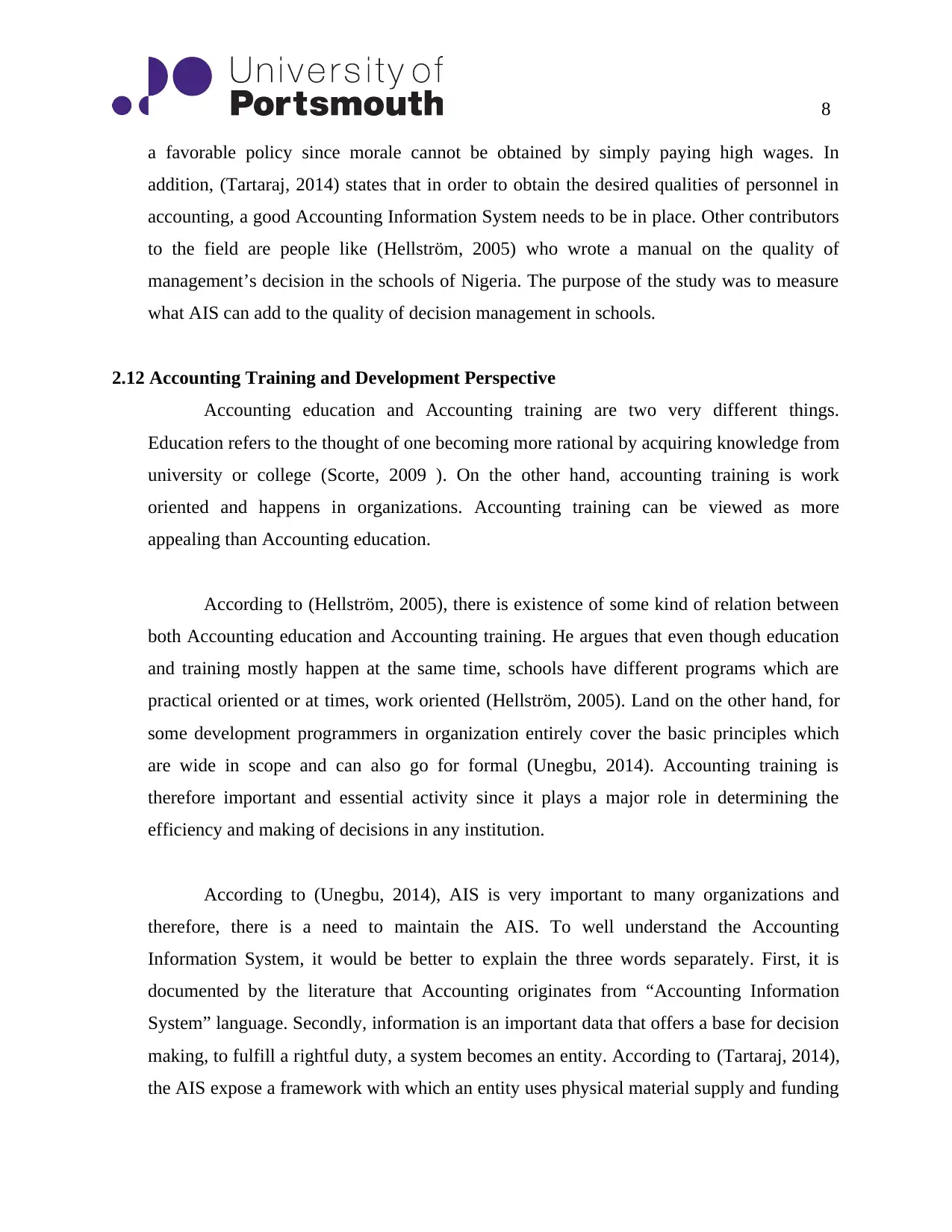
8
a favorable policy since morale cannot be obtained by simply paying high wages. In
addition, (Tartaraj, 2014) states that in order to obtain the desired qualities of personnel in
accounting, a good Accounting Information System needs to be in place. Other contributors
to the field are people like (Hellström, 2005) who wrote a manual on the quality of
management’s decision in the schools of Nigeria. The purpose of the study was to measure
what AIS can add to the quality of decision management in schools.
2.12 Accounting Training and Development Perspective
Accounting education and Accounting training are two very different things.
Education refers to the thought of one becoming more rational by acquiring knowledge from
university or college (Scorte, 2009 ). On the other hand, accounting training is work
oriented and happens in organizations. Accounting training can be viewed as more
appealing than Accounting education.
According to (Hellström, 2005), there is existence of some kind of relation between
both Accounting education and Accounting training. He argues that even though education
and training mostly happen at the same time, schools have different programs which are
practical oriented or at times, work oriented (Hellström, 2005). Land on the other hand, for
some development programmers in organization entirely cover the basic principles which
are wide in scope and can also go for formal (Unegbu, 2014). Accounting training is
therefore important and essential activity since it plays a major role in determining the
efficiency and making of decisions in any institution.
According to (Unegbu, 2014), AIS is very important to many organizations and
therefore, there is a need to maintain the AIS. To well understand the Accounting
Information System, it would be better to explain the three words separately. First, it is
documented by the literature that Accounting originates from “Accounting Information
System” language. Secondly, information is an important data that offers a base for decision
making, to fulfill a rightful duty, a system becomes an entity. According to (Tartaraj, 2014),
the AIS expose a framework with which an entity uses physical material supply and funding
a favorable policy since morale cannot be obtained by simply paying high wages. In
addition, (Tartaraj, 2014) states that in order to obtain the desired qualities of personnel in
accounting, a good Accounting Information System needs to be in place. Other contributors
to the field are people like (Hellström, 2005) who wrote a manual on the quality of
management’s decision in the schools of Nigeria. The purpose of the study was to measure
what AIS can add to the quality of decision management in schools.
2.12 Accounting Training and Development Perspective
Accounting education and Accounting training are two very different things.
Education refers to the thought of one becoming more rational by acquiring knowledge from
university or college (Scorte, 2009 ). On the other hand, accounting training is work
oriented and happens in organizations. Accounting training can be viewed as more
appealing than Accounting education.
According to (Hellström, 2005), there is existence of some kind of relation between
both Accounting education and Accounting training. He argues that even though education
and training mostly happen at the same time, schools have different programs which are
practical oriented or at times, work oriented (Hellström, 2005). Land on the other hand, for
some development programmers in organization entirely cover the basic principles which
are wide in scope and can also go for formal (Unegbu, 2014). Accounting training is
therefore important and essential activity since it plays a major role in determining the
efficiency and making of decisions in any institution.
According to (Unegbu, 2014), AIS is very important to many organizations and
therefore, there is a need to maintain the AIS. To well understand the Accounting
Information System, it would be better to explain the three words separately. First, it is
documented by the literature that Accounting originates from “Accounting Information
System” language. Secondly, information is an important data that offers a base for decision
making, to fulfill a rightful duty, a system becomes an entity. According to (Tartaraj, 2014),
the AIS expose a framework with which an entity uses physical material supply and funding
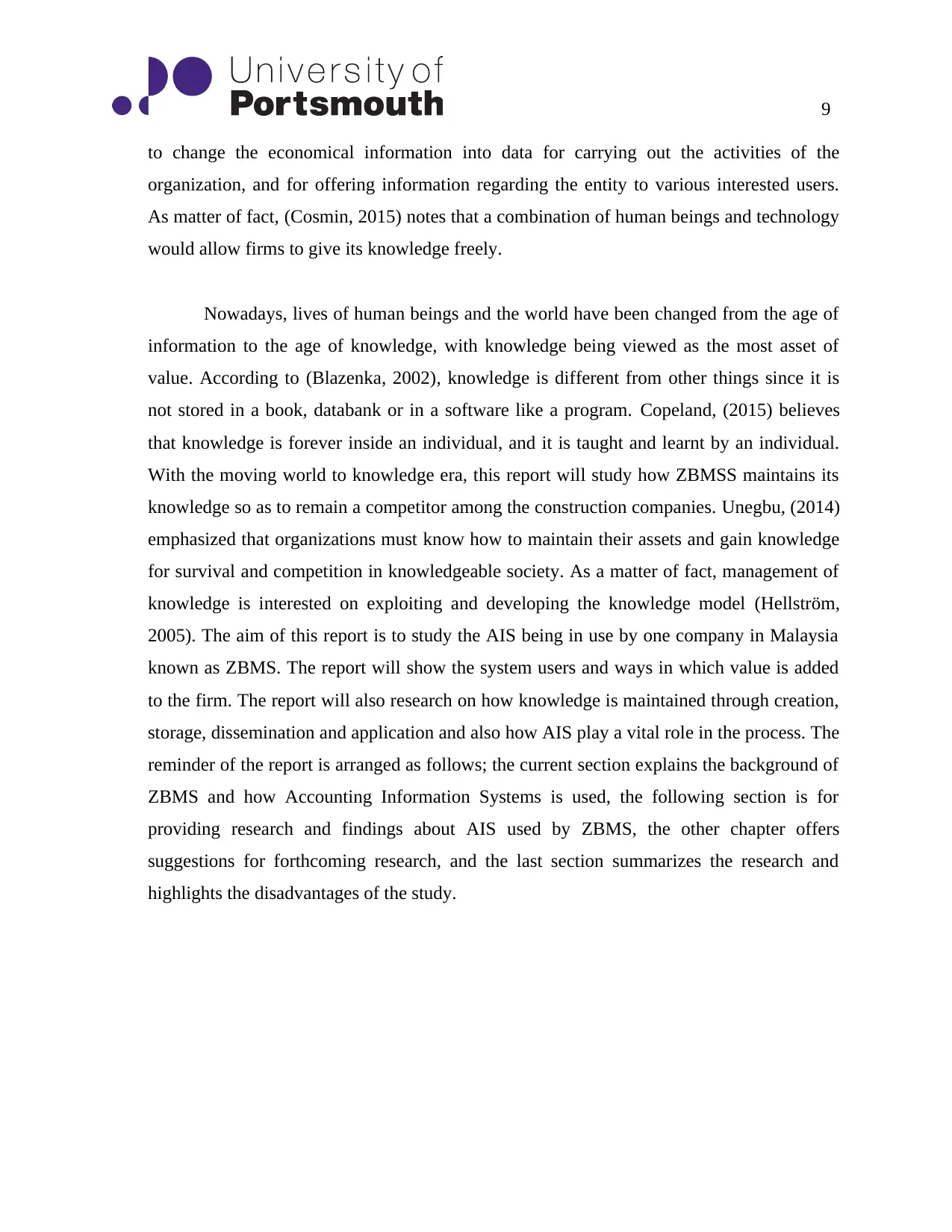
9
to change the economical information into data for carrying out the activities of the
organization, and for offering information regarding the entity to various interested users.
As matter of fact, (Cosmin, 2015) notes that a combination of human beings and technology
would allow firms to give its knowledge freely.
Nowadays, lives of human beings and the world have been changed from the age of
information to the age of knowledge, with knowledge being viewed as the most asset of
value. According to (Blazenka, 2002), knowledge is different from other things since it is
not stored in a book, databank or in a software like a program. Copeland, (2015) believes
that knowledge is forever inside an individual, and it is taught and learnt by an individual.
With the moving world to knowledge era, this report will study how ZBMSS maintains its
knowledge so as to remain a competitor among the construction companies. Unegbu, (2014)
emphasized that organizations must know how to maintain their assets and gain knowledge
for survival and competition in knowledgeable society. As a matter of fact, management of
knowledge is interested on exploiting and developing the knowledge model (Hellström,
2005). The aim of this report is to study the AIS being in use by one company in Malaysia
known as ZBMS. The report will show the system users and ways in which value is added
to the firm. The report will also research on how knowledge is maintained through creation,
storage, dissemination and application and also how AIS play a vital role in the process. The
reminder of the report is arranged as follows; the current section explains the background of
ZBMS and how Accounting Information Systems is used, the following section is for
providing research and findings about AIS used by ZBMS, the other chapter offers
suggestions for forthcoming research, and the last section summarizes the research and
highlights the disadvantages of the study.
to change the economical information into data for carrying out the activities of the
organization, and for offering information regarding the entity to various interested users.
As matter of fact, (Cosmin, 2015) notes that a combination of human beings and technology
would allow firms to give its knowledge freely.
Nowadays, lives of human beings and the world have been changed from the age of
information to the age of knowledge, with knowledge being viewed as the most asset of
value. According to (Blazenka, 2002), knowledge is different from other things since it is
not stored in a book, databank or in a software like a program. Copeland, (2015) believes
that knowledge is forever inside an individual, and it is taught and learnt by an individual.
With the moving world to knowledge era, this report will study how ZBMSS maintains its
knowledge so as to remain a competitor among the construction companies. Unegbu, (2014)
emphasized that organizations must know how to maintain their assets and gain knowledge
for survival and competition in knowledgeable society. As a matter of fact, management of
knowledge is interested on exploiting and developing the knowledge model (Hellström,
2005). The aim of this report is to study the AIS being in use by one company in Malaysia
known as ZBMS. The report will show the system users and ways in which value is added
to the firm. The report will also research on how knowledge is maintained through creation,
storage, dissemination and application and also how AIS play a vital role in the process. The
reminder of the report is arranged as follows; the current section explains the background of
ZBMS and how Accounting Information Systems is used, the following section is for
providing research and findings about AIS used by ZBMS, the other chapter offers
suggestions for forthcoming research, and the last section summarizes the research and
highlights the disadvantages of the study.
⊘ This is a preview!⊘
Do you want full access?
Subscribe today to unlock all pages.

Trusted by 1+ million students worldwide
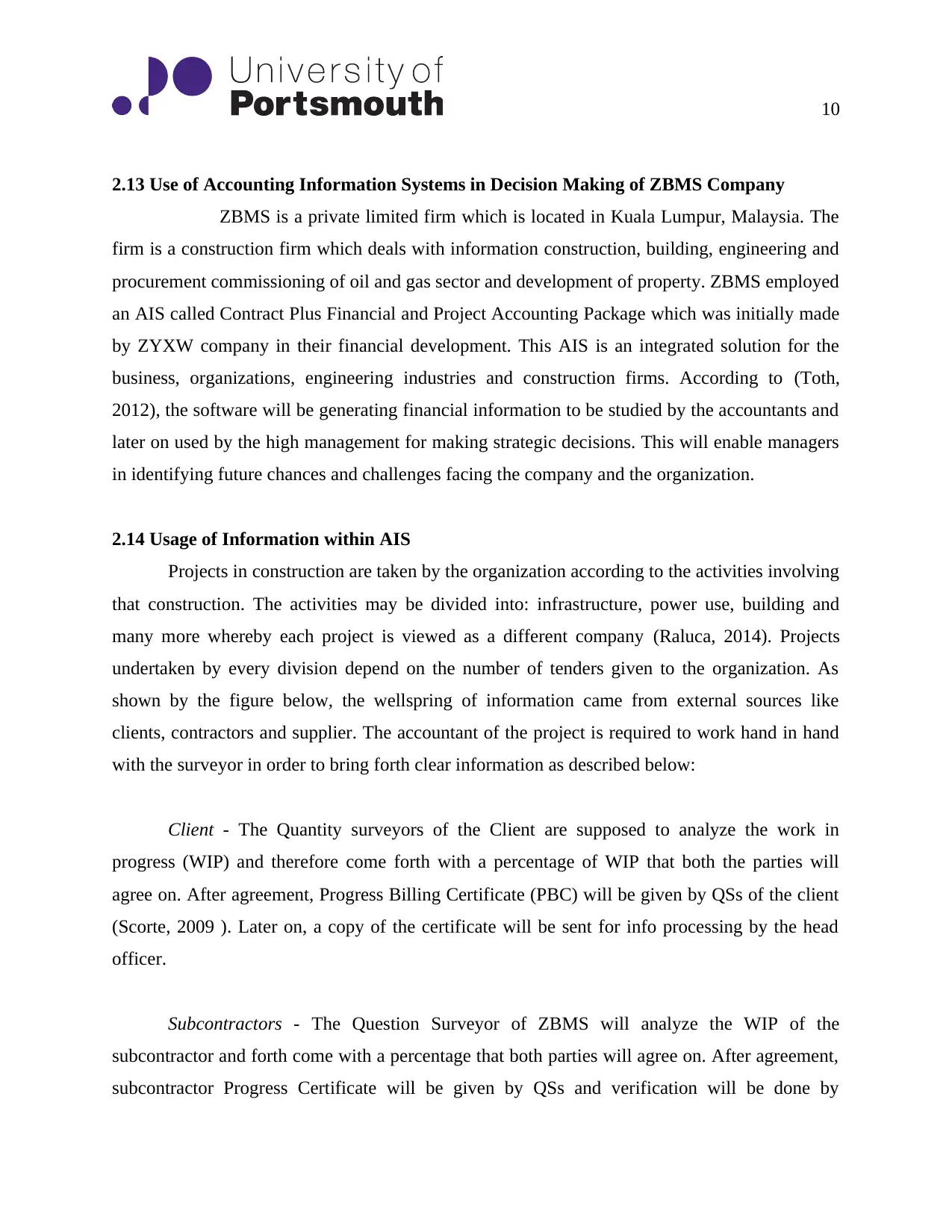
10
2.13 Use of Accounting Information Systems in Decision Making of ZBMS Company
ZBMS is a private limited firm which is located in Kuala Lumpur, Malaysia. The
firm is a construction firm which deals with information construction, building, engineering and
procurement commissioning of oil and gas sector and development of property. ZBMS employed
an AIS called Contract Plus Financial and Project Accounting Package which was initially made
by ZYXW company in their financial development. This AIS is an integrated solution for the
business, organizations, engineering industries and construction firms. According to (Toth,
2012), the software will be generating financial information to be studied by the accountants and
later on used by the high management for making strategic decisions. This will enable managers
in identifying future chances and challenges facing the company and the organization.
2.14 Usage of Information within AIS
Projects in construction are taken by the organization according to the activities involving
that construction. The activities may be divided into: infrastructure, power use, building and
many more whereby each project is viewed as a different company (Raluca, 2014). Projects
undertaken by every division depend on the number of tenders given to the organization. As
shown by the figure below, the wellspring of information came from external sources like
clients, contractors and supplier. The accountant of the project is required to work hand in hand
with the surveyor in order to bring forth clear information as described below:
Client - The Quantity surveyors of the Client are supposed to analyze the work in
progress (WIP) and therefore come forth with a percentage of WIP that both the parties will
agree on. After agreement, Progress Billing Certificate (PBC) will be given by QSs of the client
(Scorte, 2009 ). Later on, a copy of the certificate will be sent for info processing by the head
officer.
Subcontractors - The Question Surveyor of ZBMS will analyze the WIP of the
subcontractor and forth come with a percentage that both parties will agree on. After agreement,
subcontractor Progress Certificate will be given by QSs and verification will be done by
2.13 Use of Accounting Information Systems in Decision Making of ZBMS Company
ZBMS is a private limited firm which is located in Kuala Lumpur, Malaysia. The
firm is a construction firm which deals with information construction, building, engineering and
procurement commissioning of oil and gas sector and development of property. ZBMS employed
an AIS called Contract Plus Financial and Project Accounting Package which was initially made
by ZYXW company in their financial development. This AIS is an integrated solution for the
business, organizations, engineering industries and construction firms. According to (Toth,
2012), the software will be generating financial information to be studied by the accountants and
later on used by the high management for making strategic decisions. This will enable managers
in identifying future chances and challenges facing the company and the organization.
2.14 Usage of Information within AIS
Projects in construction are taken by the organization according to the activities involving
that construction. The activities may be divided into: infrastructure, power use, building and
many more whereby each project is viewed as a different company (Raluca, 2014). Projects
undertaken by every division depend on the number of tenders given to the organization. As
shown by the figure below, the wellspring of information came from external sources like
clients, contractors and supplier. The accountant of the project is required to work hand in hand
with the surveyor in order to bring forth clear information as described below:
Client - The Quantity surveyors of the Client are supposed to analyze the work in
progress (WIP) and therefore come forth with a percentage of WIP that both the parties will
agree on. After agreement, Progress Billing Certificate (PBC) will be given by QSs of the client
(Scorte, 2009 ). Later on, a copy of the certificate will be sent for info processing by the head
officer.
Subcontractors - The Question Surveyor of ZBMS will analyze the WIP of the
subcontractor and forth come with a percentage that both parties will agree on. After agreement,
subcontractor Progress Certificate will be given by QSs and verification will be done by
Paraphrase This Document
Need a fresh take? Get an instant paraphrase of this document with our AI Paraphraser
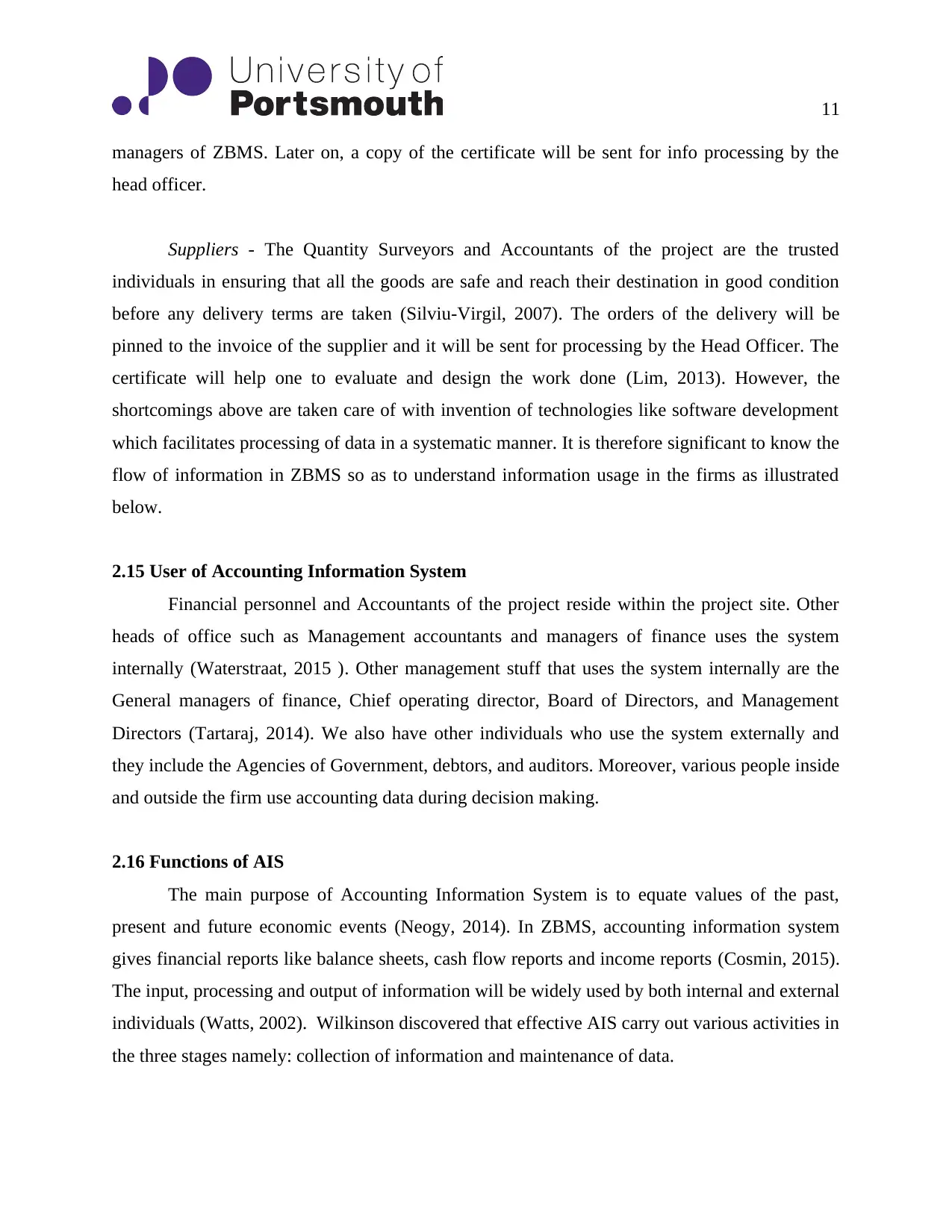
11
managers of ZBMS. Later on, a copy of the certificate will be sent for info processing by the
head officer.
Suppliers - The Quantity Surveyors and Accountants of the project are the trusted
individuals in ensuring that all the goods are safe and reach their destination in good condition
before any delivery terms are taken (Silviu-Virgil, 2007). The orders of the delivery will be
pinned to the invoice of the supplier and it will be sent for processing by the Head Officer. The
certificate will help one to evaluate and design the work done (Lim, 2013). However, the
shortcomings above are taken care of with invention of technologies like software development
which facilitates processing of data in a systematic manner. It is therefore significant to know the
flow of information in ZBMS so as to understand information usage in the firms as illustrated
below.
2.15 User of Accounting Information System
Financial personnel and Accountants of the project reside within the project site. Other
heads of office such as Management accountants and managers of finance uses the system
internally (Waterstraat, 2015 ). Other management stuff that uses the system internally are the
General managers of finance, Chief operating director, Board of Directors, and Management
Directors (Tartaraj, 2014). We also have other individuals who use the system externally and
they include the Agencies of Government, debtors, and auditors. Moreover, various people inside
and outside the firm use accounting data during decision making.
2.16 Functions of AIS
The main purpose of Accounting Information System is to equate values of the past,
present and future economic events (Neogy, 2014). In ZBMS, accounting information system
gives financial reports like balance sheets, cash flow reports and income reports (Cosmin, 2015).
The input, processing and output of information will be widely used by both internal and external
individuals (Watts, 2002). Wilkinson discovered that effective AIS carry out various activities in
the three stages namely: collection of information and maintenance of data.
managers of ZBMS. Later on, a copy of the certificate will be sent for info processing by the
head officer.
Suppliers - The Quantity Surveyors and Accountants of the project are the trusted
individuals in ensuring that all the goods are safe and reach their destination in good condition
before any delivery terms are taken (Silviu-Virgil, 2007). The orders of the delivery will be
pinned to the invoice of the supplier and it will be sent for processing by the Head Officer. The
certificate will help one to evaluate and design the work done (Lim, 2013). However, the
shortcomings above are taken care of with invention of technologies like software development
which facilitates processing of data in a systematic manner. It is therefore significant to know the
flow of information in ZBMS so as to understand information usage in the firms as illustrated
below.
2.15 User of Accounting Information System
Financial personnel and Accountants of the project reside within the project site. Other
heads of office such as Management accountants and managers of finance uses the system
internally (Waterstraat, 2015 ). Other management stuff that uses the system internally are the
General managers of finance, Chief operating director, Board of Directors, and Management
Directors (Tartaraj, 2014). We also have other individuals who use the system externally and
they include the Agencies of Government, debtors, and auditors. Moreover, various people inside
and outside the firm use accounting data during decision making.
2.16 Functions of AIS
The main purpose of Accounting Information System is to equate values of the past,
present and future economic events (Neogy, 2014). In ZBMS, accounting information system
gives financial reports like balance sheets, cash flow reports and income reports (Cosmin, 2015).
The input, processing and output of information will be widely used by both internal and external
individuals (Watts, 2002). Wilkinson discovered that effective AIS carry out various activities in
the three stages namely: collection of information and maintenance of data.
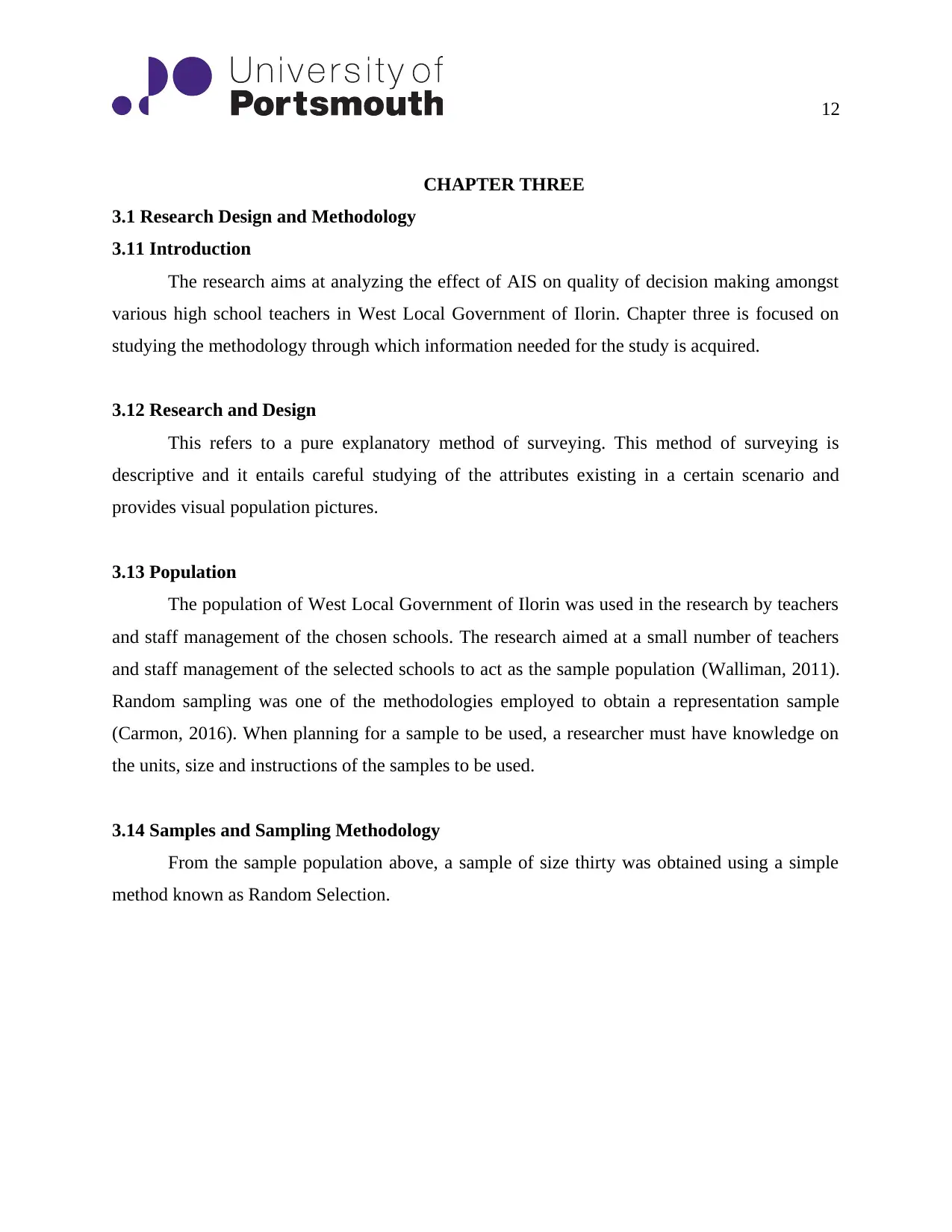
12
CHAPTER THREE
3.1 Research Design and Methodology
3.11 Introduction
The research aims at analyzing the effect of AIS on quality of decision making amongst
various high school teachers in West Local Government of Ilorin. Chapter three is focused on
studying the methodology through which information needed for the study is acquired.
3.12 Research and Design
This refers to a pure explanatory method of surveying. This method of surveying is
descriptive and it entails careful studying of the attributes existing in a certain scenario and
provides visual population pictures.
3.13 Population
The population of West Local Government of Ilorin was used in the research by teachers
and staff management of the chosen schools. The research aimed at a small number of teachers
and staff management of the selected schools to act as the sample population (Walliman, 2011).
Random sampling was one of the methodologies employed to obtain a representation sample
(Carmon, 2016). When planning for a sample to be used, a researcher must have knowledge on
the units, size and instructions of the samples to be used.
3.14 Samples and Sampling Methodology
From the sample population above, a sample of size thirty was obtained using a simple
method known as Random Selection.
CHAPTER THREE
3.1 Research Design and Methodology
3.11 Introduction
The research aims at analyzing the effect of AIS on quality of decision making amongst
various high school teachers in West Local Government of Ilorin. Chapter three is focused on
studying the methodology through which information needed for the study is acquired.
3.12 Research and Design
This refers to a pure explanatory method of surveying. This method of surveying is
descriptive and it entails careful studying of the attributes existing in a certain scenario and
provides visual population pictures.
3.13 Population
The population of West Local Government of Ilorin was used in the research by teachers
and staff management of the chosen schools. The research aimed at a small number of teachers
and staff management of the selected schools to act as the sample population (Walliman, 2011).
Random sampling was one of the methodologies employed to obtain a representation sample
(Carmon, 2016). When planning for a sample to be used, a researcher must have knowledge on
the units, size and instructions of the samples to be used.
3.14 Samples and Sampling Methodology
From the sample population above, a sample of size thirty was obtained using a simple
method known as Random Selection.
⊘ This is a preview!⊘
Do you want full access?
Subscribe today to unlock all pages.

Trusted by 1+ million students worldwide
1 out of 29
Related Documents
Your All-in-One AI-Powered Toolkit for Academic Success.
+13062052269
info@desklib.com
Available 24*7 on WhatsApp / Email
![[object Object]](/_next/static/media/star-bottom.7253800d.svg)
Unlock your academic potential
Copyright © 2020–2025 A2Z Services. All Rights Reserved. Developed and managed by ZUCOL.





